| Article ID | Journal | Published Year | Pages | File Type |
|---|---|---|---|---|
| 219752 | Journal of Electroanalytical Chemistry | 2010 | 9 Pages |
A series of transition metal substituted polyoxometalates (POMs) have been attached to carbon electrodes in multilayer films of poly(allylamine hydrochloride) (PAH). These include Wells–Dawson-derived sandwich-type Fe4III(H2O)2(As2W15O56)212-, Co4II(H2O)2(As2W15O56)216- and Mn4II(H2O)2(As2W15O56)216- and Wells–Dawson mono-substituted-type α1-[P2W17VIVO62]8− and α2-[P2W17O61(OH)2FeIII]7−. The modified electrodes were characterized by cyclic voltammetry and UV–Vis spectroscopy. The experimental observations indicate the degradation of the substituted-POMs during their incorporation in the PAH multilayer film, probably as a result of electrostatic repulsions between the positively-charged metal cation substitute (FeIII, MnII or VIV) of the POM and the positively-charged PAH. The degradation mostly results in the formation of lacunary-type POMs. Although the encapsulation does not lead to the entire preservation of the substituted-POMs, the substituted-POMs/PAH films can be used as pH sensors and as efficient electrocatalysts for the reduction of dioxygen, hydrogen peroxide and the oxidation of the NADH coenzyme.
